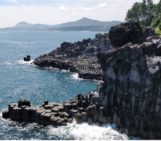
Aïda rummages around within the lavish ball pit of rock samples as often as not, but is left unsure which rock type should be her number one:
What is your favourite rock?
Dear Aïda,
I’ll be honest with you. Yeah, I’m surprised too… I don’t occupy myself that often with constructing countdown lists of rock types, and simply consider all rocks as equally and most important. Obviously. You’re an Earth scientist before anything else. However, I can satisfy your need of finding that special one leading the pack when I set my mind to it: the evaporite. I’ll tell you for why. It’s amazing stuff! When do you get an evaporite? A body of water has to – you guessed it – evaporate; simply speaking, a basin looses more water to the air than it receives from the rivers or other (maybe at that point in time dis)connected ocean basins. Result: desiccation. This doesn’t occur overnight. You can find ’em in plainly arid regions, e.g., the Great Salt Lake or desert sabkha’s. These pesky deposits are just playing in the minor leagues though. No, I’m talking about proper deposits. I’m talking about a complete sea that has evaporated. I’m talking about the Mediterranean. The Messinian Salinity crisis has left some thick layers in the deepest sections of then Mediterranean basin, in excess of 4 km at some places! Wow. The funny thing about evaporites is not the cyclicality of the deposits, or the potential purity of precipitated crystals. No, it’s the rheology. Basically, when covered by sediments and with a feel of the geotherm, an amoeba fart is enough to get the evaporite flowing. And you can get all kinds of nice shapes; domes, diapirs, pockets, and all the intermediary shapes you can think of. Evaporitic layers oftentimes acts as décollements in fold-and-thrust belts, accretionary wedges and orogens. Because of their weakness, impermeability and ability to shape other sedimentary layers, they often act as a trap for hydrocarbons. Additionally, evaporite diapirs are a prospective host location for storing nuclear waste because of their impermeability. That’s some versatility right there. Their economic relevance doesn’t stop there though. Mankind namely doesn’t like their food bland, and uses salt as their favorite additive. Luckily, one evaporite crystal is rock salt. We’ve been mining it for centuries. Don’t you think your food tastes better with a little halite? Last but not least, if you don’t really care about geology or food (what you are doing here then, I don’t know…) you can always appreciate the art and theology associated with the mines. Just look up the Realmonte or Wieliczka salt mines. I feel a city trip coming up.
Yours truly,
The Sassy Scientist
PS: This post was written in a dehydrated state. What’s that I feel on my lips?



